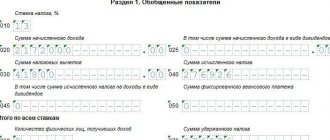Home / Taxes / What is VAT and when does it increase to 20 percent? / Declaration
Back
Published: 07/28/2017
Reading time: 5 min
0
274
The tax period for value added tax is provided for in Art. 163 Tax Code of the Russian Federation. This is a period of time (calendar code or other period) after which it is possible to determine the tax base and calculate the tax. Each tax has its own tax period, and it can combine reporting periods.
One quarter is the time of one tax period. If the enterprise was registered after January 1, the first day of its VAT tax period will coincide with the day of registration. In the event of liquidation or reorganization of an enterprise, the last tax period will coincide with the day of its liquidation (reorganization), that is, the day on which the dacha event was registered with the corresponding entry in the unified state register of legal entities.
In 2021, the VAT tax period is quarterly. In 2015, changes were approved in the Tax Code that relate to the deadlines for paying taxes to the state budget - unlike the old rules, the new ones provide for payment of the tax not on the 20th, but on the 25th. Payment must be completed within 3 months after the tax period by paying in each month in equal shares of 1/3 of the amount.
- Reporting period
- Tax period codes
Tax period codes
Tax period codes for declarations can consist of a wide variety of digital combinations: 01, 31, 34, 24, etc. They encrypt information about the tax period established by tax legislation for each tax.
IMPORTANT! A tax period is a calendar year or another period of time, after the end of which tax is calculated and paid (Clause 1, Article 55 of the Tax Code of the Russian Federation).
Next, using examples, we will decipher the period codes for individual taxes.
Main purpose
To indicate the specific period of time for which the fiscal reporting form was compiled, a special codification is provided. This code is a two-digit number, for example, tax period: 22, 34, 50.
This codification is a very convenient grouping of reporting according to the time of its formation. For example, this code allows you to quickly determine for what period of time the taxpayer made the calculation and calculated the tax to the budget.
For each type or tax reporting code (TRR), an individual codification procedure is provided. Let's look at how codes are determined for the main types of reports to the Federal Tax Service.
The category and status of the taxpayer does not matter to determine the coding. That is, the Federal Tax Service approves codes individually for each form or report form, regardless of the type of payer of fees, contributions and taxes. That is, this coding is used by legal entities, individual entrepreneurs, private practices and ordinary citizens.
Tags: balance sheet, job description of the general director, capital, tax, order, expense
VAT return tax period codes: 21, 22, 23, 24
The tax period in the VAT return is most often indicated by the numbers 21, 22, 23 and 24. They are entered in accordance with Appendix 3 to the order of the Federal Tax Service of Russia dated October 29, 2014 No. ММВ-7-3 / [email protected] , which is for tax periods 2019 -2020 applies as amended on November 20, 2019.
The numbers in the tax period code in the VAT return mean the following: the first digit of the code is a number that is always equal to 2, and the second digit varies depending on the quarter number. For example, 24 is the VAT return for the 4th quarter.
Similar codes are used in tax returns, the reporting periods for which are quarterly. In addition to VAT, such taxes, for example, include water (Article 333.11 of the Tax Code of the Russian Federation) or UTII (Article 346.30 of the Tax Code of the Russian Federation).
You will find a completed VAT return in ConsultantPlus. Try the system for free and proceed to the practical example and sample.
Taxpayers
Who pays taxes
(, , )
- All Russian legal entities (LLC, JSC, PJSC, etc.)
- Foreign legal entities that operate in Russia through permanent representative offices or simply receive income from a source in the Russian Federation
- Foreign organizations recognized as tax residents of the Russian Federation in accordance with an international treaty on taxation - for the purposes of applying this international treaty
- Foreign organizations, the place of actual management of which is the Russian Federation, unless otherwise provided by an international treaty on taxation issues
Who doesn't pay taxes
(, , , )
- Taxpayers who apply special tax regimes (Unified Agricultural Tax, simplified tax system, UTII) or are payers of the gambling business tax
- Participants of the project “Innovative
The obligation to pay tax arises only when there is an object of taxation. If there is no object, there is no reason to pay tax.
For different categories of taxpayers, profit for tax purposes may be different categories of income.
| Taxpayers | Profit for tax purposes | Article of the tax code |
| Russian organizations | Income reduced by expenses | |
| Foreign organizations operating in the Russian Federation through a permanent representative office | Income of the representative office reduced by the expenses of the representative office | |
| Other foreign organizations | Income received in the Russian Federation |
“Profitable” report with codes 21, 31, 33, 34
Reflecting the tax reporting period, code 21 in the income tax return is similar to the quarterly tax coding discussed in the previous section and means the report for the 1st quarter. The number 31 is entered in the semi-annual declaration. Code 33 denoting the tax period in the income tax return indicates that the information reflected in this document relates to the reporting period from January 1 to September 30 (for 9 months), and tax period 34 is entered in the annual “profitable” declaration.
The specified codes are not used by all taxpayers filing a “profitable” declaration. Firms that pay monthly advance payments on actually received profits use a different coding: 35, 36, 37, etc.
Such encryption of the tax period of the “profitable” declaration is provided for in Appendix 1 to the procedure for filling out the declaration, approved by Order of the Federal Tax Service dated September 23, 2019 No. ММВ-7-3/ [email protected] , applied from reporting for 2021. A similar encoding existed before.
You can see and download a practical example and a sample of filling out an income tax return in ConsultantPlus, having received free trial access to the system.
To learn about the deadlines for submitting a profit tax return, read the article “What are the deadlines for submitting an income tax return?” .
Reporting period
For each type of tax it is established separately. If it is a month or a quarter, then, as a rule, the return must be filed and the tax paid within the next month. It, unlike the tax period, determines advance payments towards the tax in its entirety.
Each type of tax has its own reporting deadlines. For taxes and fees in which the reporting period is a year, for example, 2021, the profit declaration must be submitted by March 28, for property - by March 30, according to the simplified tax system - by March 31, 2021.
Changes in tax legislation are presented in this video.
Tax period code in the payment slip: field 107
The tax period code is indicated not only in declarations, but also in payment orders for transferring tax payments to the budget. Field 107 is intended for this.
Find out how to fill out field 107 correctly in the material “Indicating the tax period in the payment order.”
Unlike the 2-digit codes indicating the tax period in declarations, the “payment” code for the tax period consists of 10 characters. Its composition:
- the first 2 characters indicate the frequency of tax payment in accordance with tax legislation (MS - month, CV - quarter, etc.);
- the next 2 characters are the number of the month (for monthly payments from 01 to 12), quarter (for quarterly payments from 01 to 04), half-year (for semi-annual payments 01 or 02);
- in 7–10 digits - indication of the year for which the tax is paid.
For example, in field 107, the tax period may look like this: “Qtr.03.2020” - this means payment of tax for the 3rd quarter of 2020.
In addition to the tax period code, payment orders for the payment of taxes also use other codes, for example the budget classification code KBK. To find out in which field of the payment order you need to indicate it, where to get information about the correct BCC and what the consequences of indicating it incorrectly, read the materials:
- “Deciphering the KBK in 2021 - 18210102010011000110, etc.”;
- “Fill in field 104 in the payment order (nuances).”
VAT reporting is quarterly or for 9 months - what is the payment deadline?
Who pays VAT: general regime payers and tax agents, as well as business entities that are exempt from VAT, but issue primary documents with a separate tax.
Value added tax is calculated based on the results of each quarter, and not on an accrual basis: it is incorrect to calculate VAT for 9 months. The tax period is a quarter (Article 163 of the Tax Code of the Russian Federation). The total payment deadline is no later than the 25th day of each of the three months following the reporting period (clause 1 of Article 174 of the Tax Code of the Russian Federation).
Based on the results of the VAT return for the 3rd quarter of 2021, when working with economic entities of the Russian Federation, VAT payers and tax agents must pay a tax in the amount of 1/3 of the total tax amount in stages. VAT payment deadlines for the 3rd quarter of 2021:
- the first part of the tax (1/3 of the total tax amount) - until October 26, 2020;
- second 1/3 – until 25.11. 2020;
- third 1/3 - until December 25, 2020.
The payment deadline in October falls on a weekend, so it is postponed to the first working day.
Special deadlines are established for import transactions and for tax agents working with foreigners.
So, enterprises importing goods from the EAEU countries pay VAT until the 20th day of the month following the one in which they accepted the goods for registration (clause 19 of Appendix No. 18 to the Treaty on the EAEU). If the leasing agreement provides for a specific payment date, then the tax is paid on the same day.
When importing goods from other countries, VAT is paid to the Federal Customs Service along with all customs duties.
Tax agents who interact with non-residents must transfer the tax simultaneously with payment for goods, works, services (clause 4 of Article 174 of the Tax Code of the Russian Federation).
Results
The code reflecting the tax period is entered in declarations and payment orders for the transfer of tax payments. A 2-digit code is used for declarations, and a 10-digit code is used for payments. Both encodings allow you to identify the tax period for which a return is filed or tax is paid.
Both in tax returns and in payments, another code is used - OKTMO. Read about its reflection in the payment order in the article “OKTMO in the payment order (nuances)”.
Sources:
- Tax Code of the Russian Federation
- Order of the Federal Tax Service of Russia dated September 23, 2019 No. ММВ-7-3/ [email protected]
- Order of the Federal Tax Service of Russia dated October 29, 2014 No. ММВ-7-3/ [email protected]
You can find more complete information on the topic in ConsultantPlus. Free trial access to the system for 2 days.
Providing a declaration
The deadlines for submitting reporting documents to the tax authorities are fixed by the Tax Code of the Russian Federation for each obligatory payment individually. Orders of the Federal Tax Service of Russia provide for tax return forms, the procedure for filling them out, lists of various codes, as well as formats for transmitting reports in electronic form.
By method
Methods for submitting the declaration are indicated on the title pages. The following codes are typical for the taxes considered:
| No. | Delivery method | Mailing | Transfer in person | Transfer via TKS | Another variant |
| 1 | Paper carrier | 01 | 02 | — | — |
| 2 | Paper media duplicated on removable media | 08 | 03 | — | — |
| 3 | Paper media with barcode | 10 | 09 | — | — |
| 4 | Electronic document signed by electronic signature | — | — | 04 | — |
| 5 | Another variant | — | — | — | 05 |
The exception is reporting on insurance premiums. It can only be passed using methods 1, 3, 4.
Local
Here are the most common places for submitting declarations and settlements:
| Code | The report is provided locally... | For which mandatory payment does it apply? |
| 120 | individual entrepreneur registration | STS, UTII, insurance premiums |
| 210 | legal entity accounting | simplified tax system |
| 213 | finding the largest taxpayer | Income and property taxes |
| 214 | registration of a legal entity not recognized as the largest taxpayer | Profit and property taxes, UTII, insurance premiums |
| 218 | finding the responsible participant in the consolidated group of payers | Income tax |
| 220 | accounting for a separate division | Income tax |
| 245 | conducting activities by a representative office of a foreign organization | Property tax, UTII |
| 310 | conducting business as a legal entity | UTII |
| 320 | conducting the activities of individual entrepreneurs | UTII |
The codes indicated on the first sheets of reporting documents deserve special attention from taxpayers. Their correct indication is the key to successful reporting and preventing unnecessary questions from tax inspectors.
Correctly filling out payment details will avoid clarifications and save valuable time for more important tasks.
Penalties
There are several situations that can provoke a violation of VAT payment standards, entailing financial penalties:
- One of the most common is incorrect calculation of the tax base . The reason for the error lies in the failure to take into account all the data from the past tax period.
- Inattentive completion of reports . Here, any incorrectly entered information can act as an error. For example, when filling out the taxpayer's details, incorrect data was entered.
- The reason may also be arrears in taxes calculated on the added value. Such nuances are usually identified by tax authorities during a desk audit.
- Deadlines for submitting the declaration . Even documentation submitted a day later than the deadline for the quarterly period becomes a serious reason for the tax authority to issue a penalty.
If one or more types of violations are identified, the tax authorities draw up a report indicating the amount of the fine that must be paid within the specified time frame. If penalties are not paid on time, penalties will begin to accrue for each day overdue.









